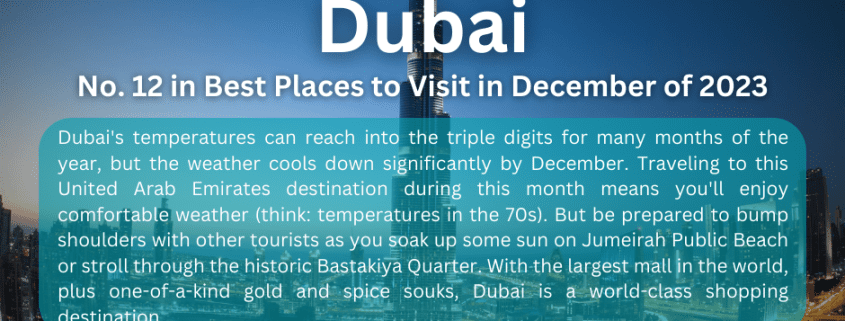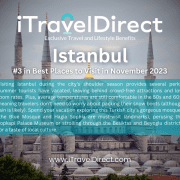Dubai #12 in Best Places to Visit in December of 2023
Why Go To Dubai
Dubai and Las Vegas have a lot in common. Both cities share a love for the fantastical, with skylines that shine like beacons against barren desert backdrops. People from all over the world flock to these shimmering oases with the same goal: to play hard. But as a vacation spot, Dubai easily trumps ol’ Sin City thanks to its gorgeous cream-colored Persian Gulf shoreline, international culinary scene, and larger-than-life attractions. And the city’s still growing; plans are underway for something bigger and better. At one point, it was estimated that a quarter of the world’s construction cranes could be found here. If that’s any sign, even the sky may not be able to limit Dubai’s growth.
Dubai is a city of superlatives, home to the world’s tallest tower, one of the world’s largest shopping malls, and one of the world’s largest man-made marinas… but on a smaller scale, this emirate is still tied to its days as a modest port town. Traditional wooden abras (boats) float past motorboats on Dubai Creek, the natural sands of Jumeirah Public Beach fringe the carefully sculpted Palm Islands, and the bustling Gold and Spice Souks (marketplaces) thrive amid the larger-than-life Dubai Mall. Despite constantly looking to the future, this city isn’t quick to let go of its past. It’s this dynamic that not only puts Dubai on the tourist map but will also keep it there.
Best Months to Visit
The best time to visit Dubai is from November to March. Weather-wise, Dubai only experiences two seasons: hot and hotter. During the winter months, the city sees blue skies and primo beach weather. However, this is also peak tourist season, so expect plenty of company on Jumeirah Beach. You can escape the crowds if you visit during the summer months but be prepared for triple-digit temps and high humidity levels.
Culture & Customs
Dubai stands as one of seven states (or “Emirates”) that make up the United Arab Emirates; the other six are Abu Dhabi, Ajman, Fujairah, Ras al-Khaimah, Sharjah and Umm al Quwain. Each emirate is governed by a sheikh, or Arabic ruler. The sheikh of Abu Dhabi acts as president of the Federal Supreme Council (both the UAE’s legislative and executive body), while the sheikh of Dubai fills the role of vice president. Although Abu Dhabi serves as the official capital of the UAE, Dubai has long been the emirates’ commercial and financial hub.
But Dubai wasn’t always the economic powerhouse it is today. Before oil was discovered in the mid-1960s, Dubai’s economy relied solely on fishing and a moderately successful pearl industry. But once oil became a point of trade about 10 years after its discovery, the economy soared, and continues to do so. The current UAE vice president of and prime minister and Dubai Sheikh, Mohammed bin Rashid Al Maktoum, is strongly invested in the city’s growth and status as a tourist hot spot.
The emirate’s role as a commercial heavyweight attracts expats from around world. Dubai’s population features citizens of 200 different nationalities, and each has left its own imprint on daily life. However, the dominant religion here is Islam, and Muslim culture greatly impacts Dubai’s society. As a result, visitors are encouraged to dress modestly here – that means no exposed chests, thighs or midriffs – and alcohol is not commonly found outside of international hotels and restaurants. Those who visit during Ramadan (the Islamic month of fasting) are encouraged to refrain from eating or drinking in public places.
Despite its size, Dubai has earned a reputation as being one of the safest places in the Middle East. The UAE remains removed from the political and religious conflicts taking place in other parts of the Middle East. Women visiting Dubai should also feel safe to move about freely. However, women are often taken aback by Emiratis’ tendency to stare; note that these gazes are most likely out of curiosity, not rudeness.
Although the official language is Arabic, Dubai’s trade history and booming tourism market means that almost everyone speaks English. American travelers can also rejoice in the fact that most major credit cards are accepted at stores, hotels and restaurants. For those paying in cash, the official currency here is the Emirati dirham (AED), which is equal to roughly $0.27. Check what the current exchange rate is before you arrive and have cash on hand when visiting Dubai’s traditional souks (markets).
What to Eat
Emirati food, the principal cuisine in Dubai, is all about one thing: spice. Put down the salt and pepper; in Dubai, all the flavor you’ll ever need is already sprinkled into the dish from a wider variety of seasonings, few of which you may not be familiar (Is za’atar in your spice cabinet? What about cardamom?). There are so many interesting and exotic dishes to sample in Dubai, the best way to navigate its rich culinary landscape is by starting with the basics.
Al machboos is the Emirati’s staple dish – think what red beans and rice are to New Orleans – and something you can’t skip on your tasting tour of the Emirates. A favorite in the home and at restaurants, al machboos appears to be a simple dish – your choice of meat topped with rice – but packs a big punch flavor-wise, because it’s seasoned with cardamom, cloves, cinnamon, dried lemon and yellow raisins. Thanks to Dubai’s location along the coast, fish is plentiful and widely used as the choice of meat in hardy dishes. M’hammar will satisfy any seafood lover’s craving for the taste of the Arabian Peninsula, prepared with locally caught fish and served with sweet yellow rice, caramelized onions and of course, a host of spices. Believe it or not, camel is widely available throughout Dubai, but is typically served on special occasions and often considered a food eaten among VIPs.
Other traditional fare to look out for are chebab, Emirati pancakes infused with saffron and cardamom and topped with yogurt and date syrup; khameer bread, which is stuffed with sweet or savory fillings, and kunafa, the Middle Eastern take on a cheese Danish. Arabic coffee is an experience in itself, especially for those who often take theirs with only cream and sugar. This coffee features regional lightly roasted beans mixed with saffron and cardamom. The ingredients are ground, boiled then strained and served in small cups. Don’t forget to satisfy your sweet tooth here either. Emiratis love their desserts. The most traditional is luqaimat, which is batter deep fried in ghee and served with local date syrup (think doughnut holes with a Middle Eastern twist). Another classic dish is balaleet, which features sweet vermicelli noodles with raisins, saffron, cardamom and other spices. And if you’re visiting during Ramadan, try Assidat al-Boubar, a pumpkin pudding made with rosewater that’s widely served after the fast is broken.
A huge part of what has shaped Dubai’s food landscape is the melting pot of cultures (more than 200 nationalities) that share the city. Aside from Emirati establishments, you’ll find restaurants serving everything from classic French fare to dim sum. If you want flash, definitely go to one of the Burj Al Arab’s restaurants. There’s also La Petite Maison, a Michelin star-rated French import that sits near the Four Seasons. For beloved (and cheaper) casual eateries, head over to Al Samadi Sweets for Lebanese and Arabic dessert, or kick back and relax at Seven Sands, the oceanfront restaurant at Jumeirah Beach Residence. For more information about where to eat, check out the Dubai tourism board’s website.
Getting Around Dubai
The best way to get around Dubai is by taxi or by metro. Although prices are high across the board in Dubai, a taxi here or there won’t break the bank. Plus, they provide the freedom to move at your own pace without the hassle of navigating traffic. Dubai’s metro system transports passengers to major areas of interest, including Burj Khalifa and the Dubai International Airport (DXB). The airport is about 10 miles from downtown Dubai. You can also rent a car at the airport, but be forewarned: driving here is not for the faint-hearted.
Taxi
Taxis are the most cost- and time-efficient means of getting around Dubai. You can easily spot cabs by their tan bodies and red roofs; the pink-topped cabs are designated for female and family passengers only (they are also driven by women). All taxis are metered, with rates starting at 12 dirhams (roughly $3.25) and increasing by about 2.82 dirhams (around $0.75) per mile. Because Dubai addresses do not include building numbers, you’ll have to specify your destination based on an intersection or a nearby hotel or landmark. Taxis also service Dubai International Airport for a flat rate of 20 dirhams (roughly $5.50). Uber also operates in Dubai.
Bus
The Roads & Transport Authority (RTA) operates more than 100 routes in Dubai. Like the metro, bus fares range depending on which of the seven zones you plan to travel through. You can pay using a Nol Card, which you can purchase at select bus stations, ticket vending machines and RTA service centers throughout the city. Although buses run frequently, you will need to factor traffic delays and frequent stops into your travel time. Bus no. 8 tends to be one of the most useful routes for travelers since it makes stops at some of the tourist hot spots, including the Burj Al Arab and the Dubai Marina.
Metro
Dubai’s metro consists of two lines: the red line and the green line. Both lines together service nearly 50 stations, including the airport. The routes are divided into zones, and fares vary depending on which zones are traveled through. You can pay for your trip with a Nol Card, which is valid on Dubai’s metro, buses and waterbuses. You can purchase a Nol Card in all metro stations. Hours of operation depend on the day and line, but they usually start operating around 5 or 5:30 a.m. and run until midnight or 1 a.m. the following day. However, on Fridays it’s important to note that metro trains don’t start operating until 10 a.m.
Boat
Boats have always played a primary role in Dubai transportation, and today, they are still frequently used by both locals and tourists who need to cross Dubai Creek. For 1 dirham (roughly $0.27) per trip, you can cross the creek via abra, the traditional wooden boat that has graced Dubai’s waters for years and years. You’ll find abras lining the creek in the downtown area. Just make sure to carry cash, as drivers don’t accept cards.
The Roads & Transport Authority also operates a boat service known as the Dubai Waterbus. These are more spacious and high-tech than abras (and provide air conditioning), and they service stations outside of the immediate downtown area. One-way trips cost 2 dirhams (roughly $0.54), and you can pay using your Nol Card.
Car
Dubai’s roads are well maintained and clearly labeled; however, it can be difficult to maneuver through all the constant construction and traffic. You should also keep in mind that finding parking can be troublesome too. That being said, a car will come in handy should you want to venture outside of Dubai city. You can rent a car in town or at the Dubai airport. To drive here, you will need to obtain an international driver’s license.
Start Saving with iTravelDirect’s Exclusive Travel and Lifestyle Benefits Membership
CLICK HERE to Test-Drive our Guaranteed Savings
We offer a 110% Price Guarantee – Find a lower price anywhere online and we will refund you 110% of the difference.
CLICK HERE for a full list of services and Membership Discounts.
When you join iTravelDirect, you’ll have full access to all club benefits.
Your membership gives you the freedom to travel when you want, to where you want.
And you won’t find lower rates anywhere, guaranteed. So, pack your bags and start planning that vacation of a lifetime today!












Leave a Reply
Want to join the discussion?Feel free to contribute!